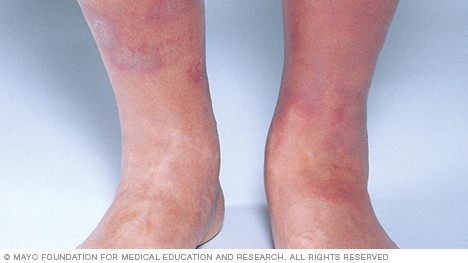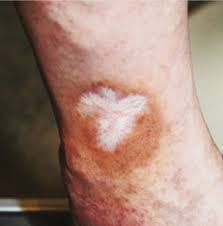Why Skin Discoloration Can be a Sign of Vascular Disease
“My skin looks dirty, but I took a shower this morning.” This is something I commonly hear when talking to patients. This may not only be embarrassing for patients, but also lead to skin damage and wounds. There are different types of skin discoloration that are related to vascular disease. Most of them are due to veins that are not functioning properly. Below is a summary of the most common skin conditions that are seen as related to vascular disease.
Stasis Dermatitis
I recently saw a patient who had red, itchy skin with swelling. She had been to urgent care and was prescribed antibiotics. She didn't feel the antibiotic was helping. She was being treated for a skin infection. However, she really had stasis dermatitis. Stasis dermatitis appears as a redness due to skin irritation that occurs from blood pooling in the lower legs. This leads to inflammation, which can make the skin feel warm or itchy. This is commonly mistaken for cellulitis. Many times, stasis dermatitis is temporary, and with proper treatment, the legs can return to normal. Treatment consists of leg elevation, wearing compression stockings, and exercising. Standing still makes symptoms worse. Professions, where this is commonly seen, are hairdressers, teachers, cashiers, and waiters.

Hyperpigmentation
Hyperpigmentation is a dark discoloration or rusty appearance of the lower legs. When patients tell me their skin looks dirty no matter how much they scrub, the staining to their skin is usually from hyperpigmentation. This occurs from a hemosiderin stain – which is iron leaking from the vessels and turning the skin dark. This usually happens slowly over time. Unfortunately, once hyperpigmentation is present it is usually permanent. Proper vein treatment can help limit the discoloration from worsening.
Atrophy Blanche
Atrophy Blanche is a white or pale discoloration that is seen after skin damage has taken place. It is most commonly the result of a healed venous ulcer or wound. This area of skin is very delicate and is prone to becoming a wound. Once Atrophy Blanche is seen on the skin it is important to wear compression stockings daily. Also, follow your provider’s recommendations for any needed deep or superficial vein treatments.

Rubor
Rubor is a red discoloration that is related to advancing arterial disease and is very worrisome. If not treated swiftly this can lead to dead tissue in the form of wounds and gangrene. If a patient has rubor there is typically foot pain. The pain will worsen with walking and improve with rest. Also, the patient may feel pain while lying in bed, causing the patient to dangle the foot of the side for relief. This is called rest pain. This needs immediate attention, and the patient should contact a vascular specialist as soon as possible.
In conclusion, the best way to protect your skin from vascular discoloration is to seek an evaluation if you are experiencing any signs or symptoms. If you are noticing any of these skin changes, we highly recommend that you schedule an appointment with your doctor or medical professional. You can also visit leg discoloration treatment & causes for more information and schedule an appointment with one of the accredited vascular physicians.

